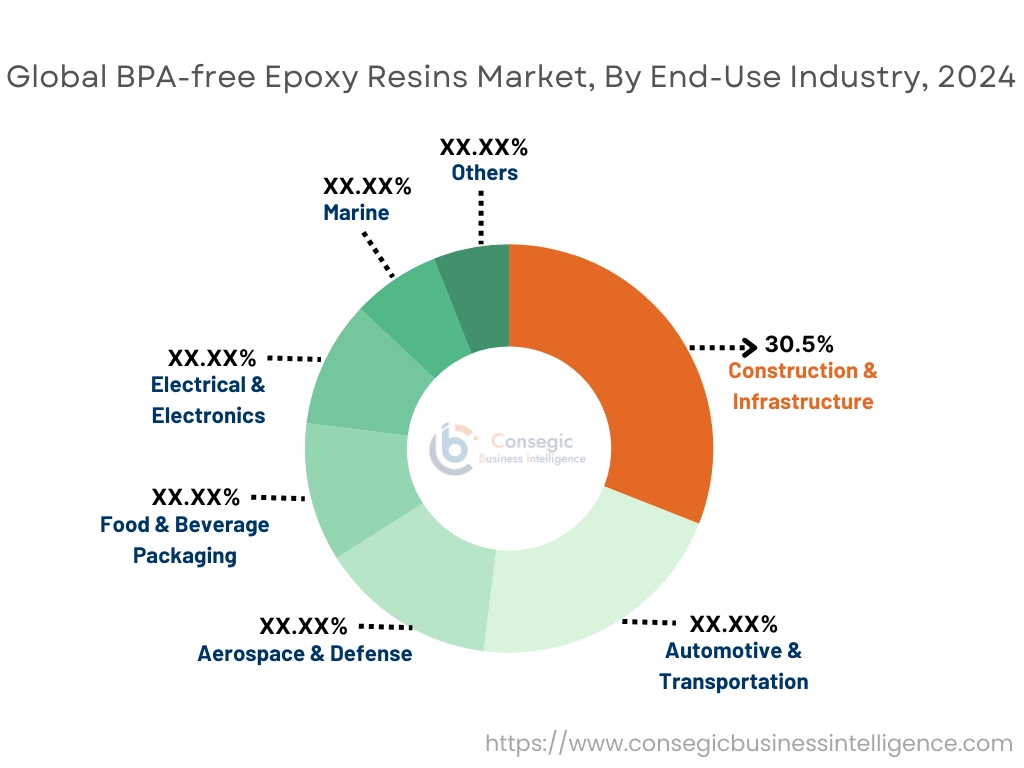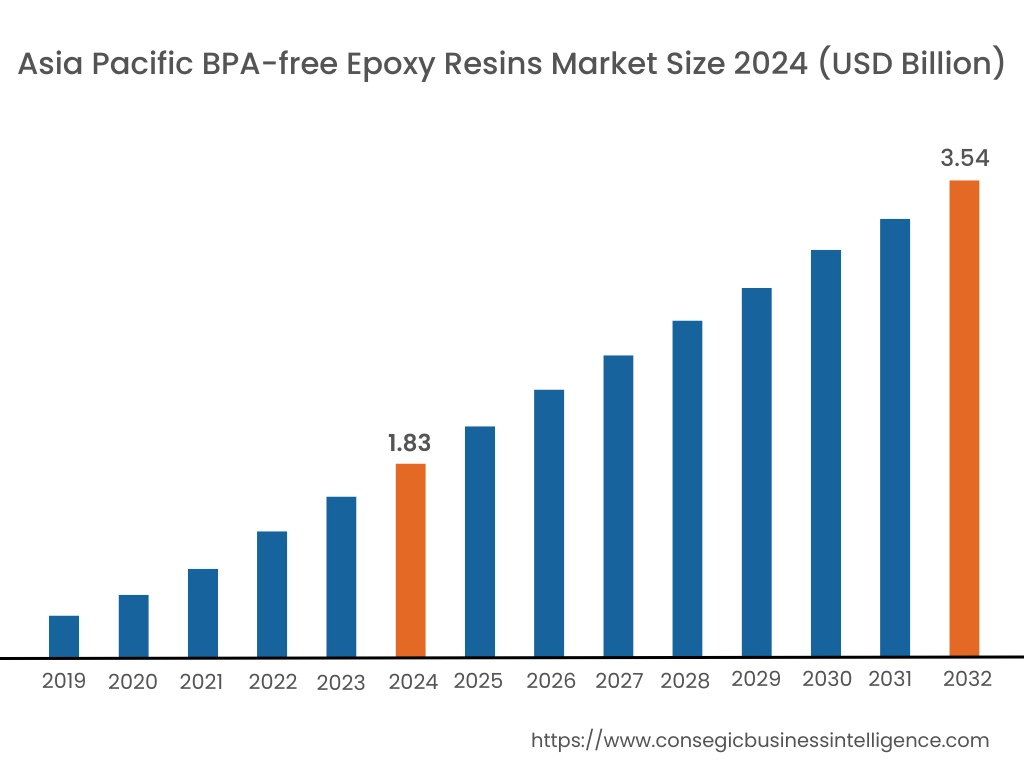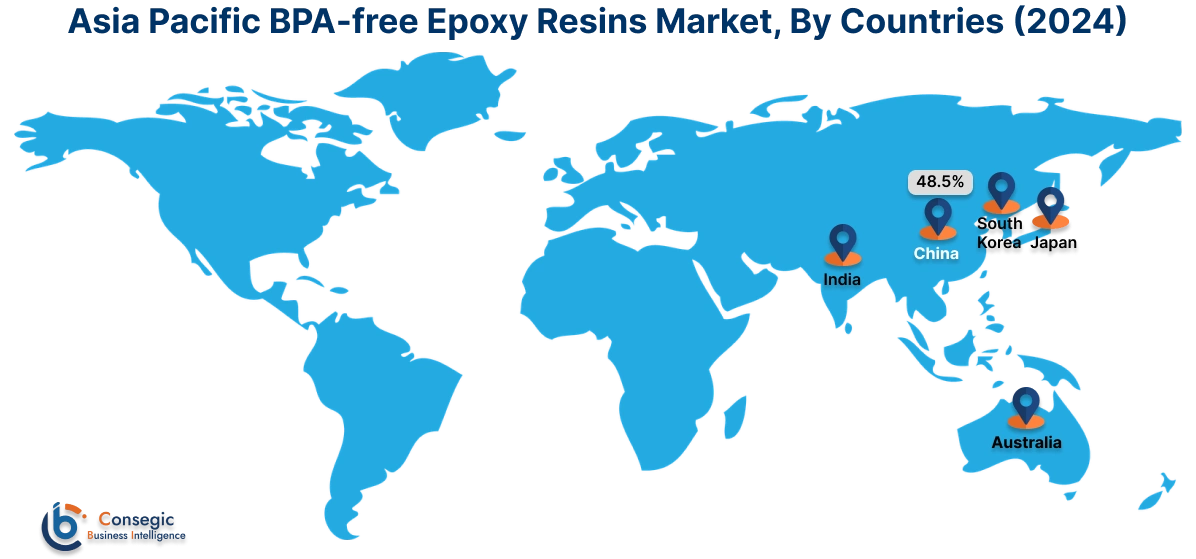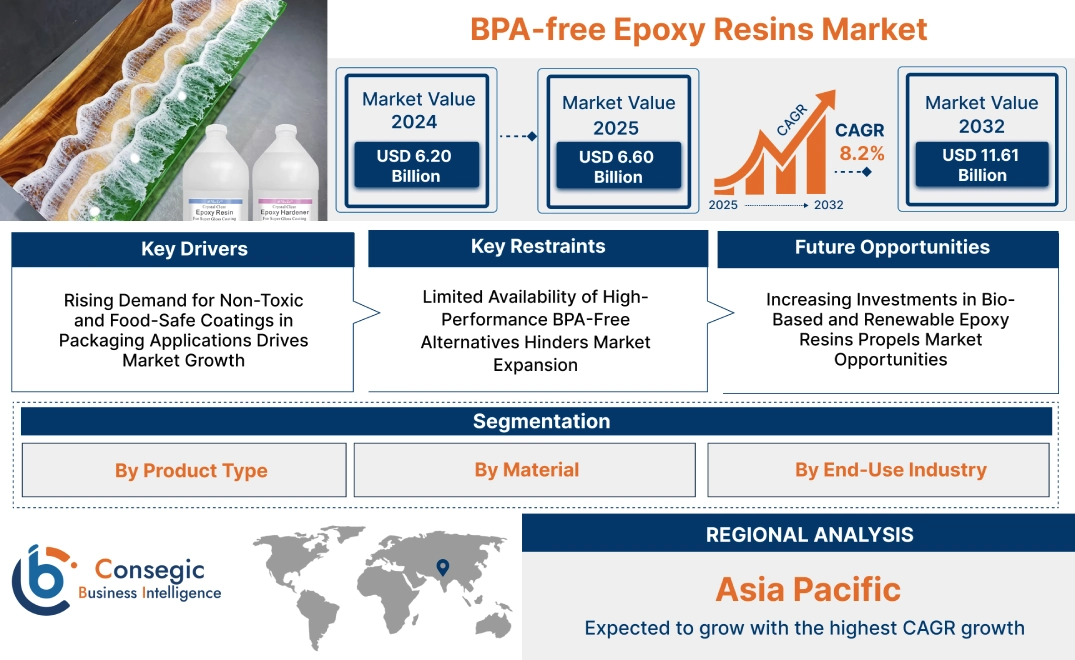BPA-free Epoxy Resins Market Size:
BPA-free Epoxy Resins Market size is estimated to reach over USD 11.61 Billion by 2032 from a value of USD 6.20 Billion in 2024 and is projected to grow by USD 6.60 Billion in 2025, growing at a CAGR of 8.2% from 2025 to 2032.
BPA-free Epoxy Resins Market Scope & Overview:
BPA-free epoxy resins are epoxy resins that are manufactured without using bisphenol A (BPA), a chemical known for its potential health and environmental impacts. These resins offer a safer alternative to traditional BPA-based epoxies, addressing concerns about potential endocrine disruption and other health risks. BPA is a chemical used in the production of traditional epoxy resins, and it has been linked to various health issues, including potential endocrine disruption and other adverse effects. BPA is a chemical used in the production of traditional epoxy resins, and it has been linked to various health issues, including potential endocrine disruption and other adverse effects. These resins are developed using alternative chemicals to offer more sustainable and safer products.
BPA-free Epoxy Resins Market Dynamics - (DRO):
Key Drivers:
Rising demand for non-toxic and food-safe coatings in packaging applications drives market growth
BPA-free epoxy resins are increasingly used in food packaging and containers because of safety concerns and regulations surrounding BPA. These resins are engineered to be BPA-free or contain extremely low levels of BPA, meeting the requirements of food safety authorities. They offer excellent chemical resistance, strong adhesion, and toughness, making them suitable for various applications. These resins retain the desirable properties of traditional epoxy resins, such as strong adhesion, chemical resistance, and toughness.
- For instance, in December 2024, the EU banned the use of BPA in food contact materials due to its harmful health effects, specifically on the immune system.
Therefore, the aforementioned factors are driving the BPA-free epoxy resins market growth.
Key Restraints:
Availability of high-performance BPA-free alternatives hinders market expansion
Solvay Specialty Polymers has developed a bio-based PAES copolymer that is both BPA and BPS-free. It is derived from renewable plant-based sources like corn or wheat, making it more sustainable. This copolymer demonstrates improved scratch, UV, heat, and impact resistance as compared to BPA-based materials. Solvay Specialty Polymers also offers these polymers for thermal printing applications, which enhance the eco-compliance of existing products or create new ones. A new route towards bisguaiacols, a sustainable alternative to BPA, has been developed using arenes and alkenes derived from lignin, a widely available biopolymer. Thus, market analysis depicts that the aforementioned factors are hindering the BPA-free epoxy resins market demand.
Future Opportunities:
Rising investments in bio-based and renewable epoxy resins propels market opportunities
Bio-based epoxy resins are environmentally friendly alternatives to traditional petroleum-derived epoxy resins, utilizing plant-based materials like vegetable oils and agricultural byproducts. They offer similar performance characteristics, including strong adhesion, durability, and chemical resistance, but with reduced carbon footprint and reliance on fossil fuels. Bio-based epoxies offer comparable or even superior mechanical properties, durability, and chemical resistance to their petroleum-based counterparts. They can be used in a wide range of industries, including coatings, adhesives, composites, construction, and electronics.
- For instance, in November 2023, AGC Vinythai and Michigan State University’s Prof. Mojgan Nejad collaborated with Allnex to replace BPA in epoxy resin with lignin.
Thus, the market analysis depicts that the advancements in bio-based and renewable epoxy resins are creating new BPA-free epoxy resins market opportunities.
BPA-free Epoxy Resins Market Segmental Analysis :
By Product Type:
By product type, the market is categorized into waterborne, solvent-borne, and powder.
Trends in the Product Type:
- Rising demand for solvent-borne in certain applications due to their ability to be applied with different techniques and their relatively low viscosity is boosting the market growth.
- Increasing trend in the adoption of powder BPA-free epoxy resins to be used in steel rebar and coat pipelines is boosting the BPA-free epoxy resins market size.
The waterborne segment held the largest share in the BPA-free epoxy resins market in 2024.
- BPA-free, waterborne epoxy resins are designed to be eco-friendly and versatile.
- They offer similar performance to traditional BPA-containing epoxy resins but without the health and environmental concerns associated with BPA.
- Waterborne epoxy resins can be used in a wide range of applications, including coatings for various surfaces, adhesives for bonding materials, and binders in composite materials.
- By using waterborne formulations, manufacturers can reduce their reliance on petrochemicals and create more sustainable products.
- Therefore, the aforementioned factors are driving the BPA-free epoxy resins market growth.
The powder segment is anticipated to experience the fastest CAGR during the forecast period.
- BPA-free epoxy resins are formulated as powder coatings, which are applied by electrostatic spraying or other methods.
- Powder coatings offer advantages over liquid coatings, such as no VOCs, higher film thickness, and the ability to coat complex shapes.
- They are used in various applications, including coating pipelines, poles, and steel rebars in concrete structures.
- Epoxy-based powder coatings are used to coat pipelines and steel rebars in high-load-bearing concrete structures.
- Thus, the market analysis depicts that the aforementioned factors are expected to drive the BPA-free epoxy resins market trends.
By Material:
By material, the market is segmented into acrylic-based coatings, vinyl-based coatings, oleo, polyethylene, and others.
Trends in the Material:
- Rising adoption of BPA-free vinyl coatings due to numerous advantages, primarily in terms of safety, flexibility, and durability is driving the market growth.
- Increasing trend in the adoption of oleo due to the minimized risk of harmful chemicals leaching into food and beverages is boosting the BPA-free epoxy resins market size.
The acrylic-based coatings segment held the largest market share in the BPA-free epoxy resins market share in 2024.
- BPA-free acrylic coatings offer excellent moisture and gas barrier properties, and a smooth finish, and are suitable for various applications including food packaging and decorative finishes.
- They are a safe alternative to coatings containing BPA, a chemical with potential health concerns.
- Additionally, acrylic coatings can be tailored to meet specific application requirements, such as corrosion resistance, UV resistance, adhesion, and chemical resistance.
- Acrylic polymers inherently exhibit low water absorption, making them suitable for waterproofing applications.
- Thus, the market analysis shows that the aforementioned factors are driving the BPA-free epoxy resins market demand.
The polyethylene segment is expected to have the fastest CAGR during the forecast period.
- Polyethylene (PE) is naturally BPA-free and a common thermoplastic used in various applications.
- It is a widely used polymer, known for its low cost, easy processability, and good chemical resistance.
- Polyethylene, particularly low-density polyethylene (LDPE) and linear low-density polyethylene (LLDPE) is often used in food packaging and other applications.
- BPA-free polyethylene offers a safer and more environmentally friendly alternative to traditional plastics containing BPA, benefiting both consumer health and the environment.
- Consequently, the aforementioned factors are driving the BPA-free epoxy resins market trends.
By End-Use Industry:
By end-use industry, the market is segmented into construction & infrastructure, automotive & transportation, aerospace & defense, food & beverage packaging, electrical & electronics, marine, and others.
Trends in the End-Use Industry:
- Rising demand for BPA-free epoxy resins in aerospace & defense due to properties including strong adhesion, chemical resistance, and toughness is boosting the market growth.
- Increasing trend of adoption of BPA-free epoxy resins in automotive & transportation for strong adhesion, chemical resistance, and toughness, and growing demand for environmentally friendly materials are driving the market.
The food & beverage packaging segment held the largest BPA-free epoxy resins market share of 30.5% in 2024.
- BPA-free epoxy resins are gaining importance in food and beverage packaging due to health concerns associated with traditional BPA-based epoxy resins, which can leach into food and beverages, potentially causing endocrine disruption.
- These resins offer a safer alternative, providing strong adhesion, chemical resistance, and durability for packaging applications.
- These resins provide superior adhesion, chemical resistance, and durability as compared to traditional BPA-based epoxy resins, making them ideal for various food and beverage packaging applications.
- The increasing awareness of BPA's potential health risks has led to regulations and consumer preferences that favor BPA-free alternatives.
- Thus, the BPA-free epoxy resins market analysis shows that the aforementioned factors are driving the BPA-free epoxy resins market expansion.
The electrical & electronics segment is expected to experience the fastest CAGR during the forecast period.
- BPA-free epoxy resins are increasingly important in electrical and electronic applications due to their excellent electrical insulation, mechanical strength, and chemical resistance.
- These resins are used in encapsulating components as adhesives, and for creating circuit boards and other electronic components.
- These resins provide excellent insulation, preventing electrical shorts and ensuring the reliable operation of electronic devices.
- They offer high tensile strength, impact resistance, and toughness, protecting delicate electronic components from damage.
- They resist corrosion from various chemicals, moisture, and other environmental factors, ensuring the long-term durability of electronic components.
- Therefore, the aforementioned factors are driving the BPA-free epoxy resins market opportunities.

Regional Analysis:
The regions covered are North America, Europe, Asia Pacific, the Middle East and Africa, and Latin America.

Asia Pacific region was valued at USD 1.83 Billion in 2024. Moreover, it is projected to grow by USD 1.95 Billion in 2025 and reach over USD 3.54 Billion by 2032. Out of this, China accounted for the maximum revenue share of 48.5%. The Asia Pacific region is witnessing a rapid increase in the BPA-free epoxy resins industry, primarily due to rising demand from electrical and electronic devices, and food & beverage sectors, among others. Moreover, the growing health and environmental concerns, stricter regulations, and the rising adoption of sustainable materials are driving the BPA-free epoxy resins market expansion.

North America is estimated to reach over USD 3.76 Billion by 2032 from a value of USD 2.06 Billion in 2024 and is projected to grow by USD 2.18 Billion in 2025. In North America, the market is expanding due to growing concerns about the health effects of Bisphenol A (BPA) and stricter regulations. This shift is driven by the need for safer materials in various applications, particularly in the paint and coating industries, where BPA-based coatings have been linked to health issues.
The BPA-free epoxy resins market analysis shows that Europe holds a significant share of the market primarily due to rising popularity due to stricter regulations and growing awareness of the potential health impacts of BPA. The Latin American market is growing, driven by increased construction and automotive industries, along with a focus on sustainability and renewable energy. The Middle East and Africa region presents growth prospects for the market, particularly in the stricter regulations, growing health concerns about BPA exposure, and the need for sustainable alternatives.
Top Key Players & Market Share Insights:
The BPA-free epoxy resins market is highly competitive with major players providing products and services to the national and international markets. Key players are adopting several strategies in research and development (R&D), product innovation, and end-user launches to hold a strong position in the global BPA-free epoxy resins market. Key players in the BPA-free epoxy resins industry include -
- Hempel A/S (Denmark)
- Allnex (Germany)
- Eastman Chemical Company (USA)
- BASF SE (Germany)
- Sun Chemical (USA)
- ISTOYO (USA)
- Westlake Epoxy (USA)
- CREKOAT (China Olin Corporation (USA))
Recent Industry Developments :
Acquisitions:
- In February 2021, Westlake Chemical Corporation acquired Hexion Inc.’s global epoxy business. This transaction allowed Westlake to expand its downstream portfolio of coatings and composite products.
BPA-free Epoxy Resins Market Report Insights:
| Report Attributes | Report Details |
| Study Timeline | 2019-2032 |
| Market Size in 2032 | USD 11.61 Billion |
| CAGR (2025-2032) | 8.2% |
| By Product Type |
|
| By Material |
|
| By End-Use Industry |
|
| By Region |
|
| Key Players |
|
| North America | U.S. Canada Mexico |
| Europe | U.K. Germany France Spain Italy Russia Benelux Rest of Europe |
| APAC | China South Korea Japan India Australia ASEAN Rest of Asia-Pacific |
| Middle East and Africa | GCC Turkey South Africa Rest of MEA |
| LATAM | Brazil Argentina Chile Rest of LATAM |
| Report Coverage |
|
Key Questions Answered in the Report
How big is the BPA-free Epoxy Resins Market? +
BPA-free Epoxy Resins Market size is estimated to reach over USD 11.61 Billion by 2032 from a value of USD 6.20 Billion in 2024 and is projected to grow by USD 6.60 Billion in 2025, growing at a CAGR of 8.2% from 2025 to 2032.
What specific segmentation details are covered in the BPA-free Epoxy Resins Market report? +
The BPA-free Epoxy Resins market report includes specific segmentation details for product type, material and end-use industry.
Which is the fastest-growing region in the BPA-free Epoxy Resins Market? +
Asia Pacific is the fastest-growing region in the BPA-free Epoxy Resins market. These trends are encouraged by increasing demand from various end-use industries such as electronics, automotive, and construction.
Who are the major players in the BPA-free Epoxy Resins Market? +
The key participants in the BPA-free Epoxy Resins market are Hempel A/S (Denmark), Allnex (Germany), Sun Chemical (USA), ISTOYO (USA), Westlake Epoxy (USA), CREKOAT (China), Olin Corporation (USA), Eastman Chemical Company (USA) and BASF SE (Germany).


